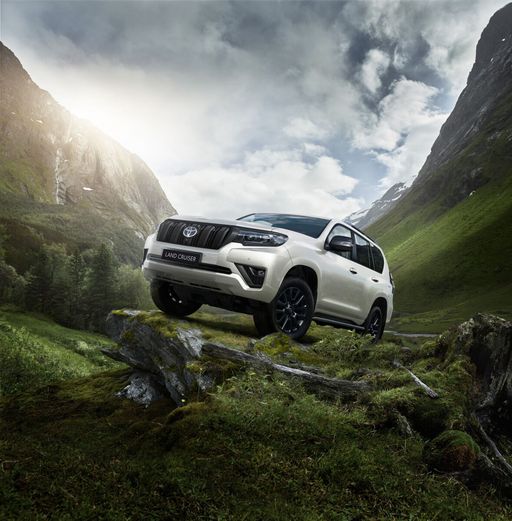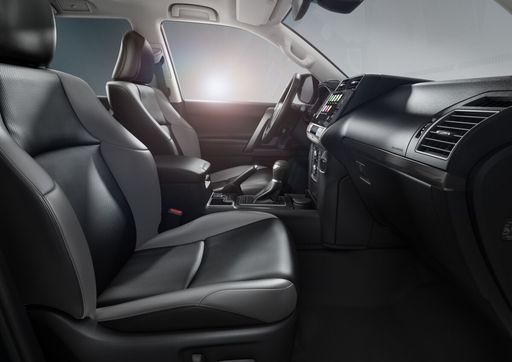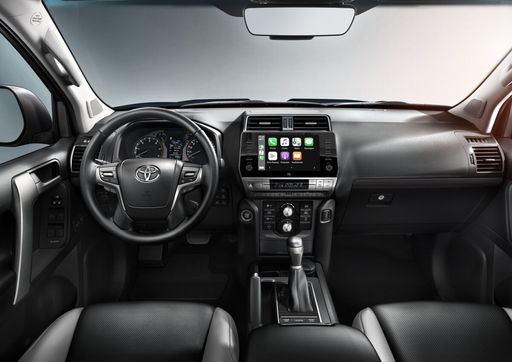Renault Master Bus vs Toyota Land Cruiser – Differences & prices compared
Compare performance, boot space, consumption and price in one view.
Find out now: which car is the better choice for you – Renault Master Bus or Toyota Land Cruiser?
The Renault Master Bus (Bus) comes with a Diesel engine and Manuel or Automatic transmission. In comparison, the Toyota Land Cruiser (Off-Roader) features a Diesel engine with Automatic transmission.
When it comes to boot capacity, the Renault Master Bus offers , while the Toyota Land Cruiser provides 742 L – depending on how much space you need. If you’re looking for more power, decide whether the 180 HP of the Renault Master Bus or the 205 HP of the Toyota Land Cruiser suits your needs better.
In terms of consumption, the values are 8.70 L per 100 km for the Renault Master Bus, and 10.30 L for the Toyota Land Cruiser.
Price-wise, the Renault Master Bus starts at 36600 £, while the Toyota Land Cruiser is available from 58300 £. Compare all the details and find out which model fits your lifestyle best!
Renault Master Bus
The Renault Master Bus offers a spacious and flexible interior, making it an excellent choice for transporting groups comfortably. It features a robust design and advanced safety systems, ensuring a secure ride for all passengers. With its efficient diesel engine, the Master Bus combines power with impressive fuel economy, appealing to both businesses and private users alike.
detailsToyota Land Cruiser
The Toyota Land Cruiser is renowned for its robust durability and exceptional off-road capabilities. Its design combines a rugged exterior with a comfortable and functional interior, appealing to both adventure seekers and city drivers. The vehicle's reliability and advanced technology make it a popular choice for those who require a dependable SUV that can handle a variety of terrains with ease.
details @ Toyota
@ Toyota
 @ Toyota
@ Toyota
 @ Toyota
@ Toyota

|
|
|
|
|
Costs and Consumption |
|
|---|---|
|
Price
36600 - 43200 £
|
Price
58300 - 78400 £
|
|
Consumption L/100km
8.7 - 10.7 L
|
Consumption L/100km
10.30 L
|
|
Consumption kWh/100km
-
|
Consumption kWh/100km
-
|
|
Electric Range
-
|
Electric Range
-
|
|
Battery Capacity
-
|
Battery Capacity
-
|
|
co2
227 - 280 g/km
|
co2
272 g/km
|
|
Fuel tank capacity
105 L
|
Fuel tank capacity
80 L
|
Dimensions and Body |
|
|---|---|
|
Body Type
Bus
|
Body Type
Off-Roader
|
|
Seats
6 - 9
|
Seats
5
|
|
Doors
4
|
Doors
5
|
|
Curb weight
2189 - 2361 kg
|
Curb weight
2410 - 2550 kg
|
|
Trunk capacity
-
|
Trunk capacity
130 - 742 L
|
|
Length
5075 - 5575 mm
|
Length
4925 mm
|
|
Width
2070 mm
|
Width
1980 mm
|
|
Height
2290 - 2486 mm
|
Height
1935 mm
|
|
Payload
939 - 1254 kg
|
Payload
600 - 690 kg
|
Engine and Performance |
|
|---|---|
|
Engine Type
Diesel
|
Engine Type
Diesel
|
|
Transmission
Manuel, Automatic
|
Transmission
Automatic
|
|
Transmission Detail
Manual Gearbox, Automated Manual
|
Transmission Detail
Automatic Gearbox
|
|
Drive Type
Front-Wheel Drive
|
Drive Type
All-Wheel Drive
|
|
Power HP
135 - 180 HP
|
Power HP
205 HP
|
|
Acceleration 0-100km/h
-
|
Acceleration 0-100km/h
-
|
|
Max Speed
150 - 165 km/h
|
Max Speed
170 km/h
|
|
Torque
360 - 400 Nm
|
Torque
500 Nm
|
|
Number of Cylinders
4
|
Number of Cylinders
4
|
|
Power kW
99 - 132 kW
|
Power kW
151 kW
|
|
Engine capacity
2299 cm3
|
Engine capacity
2755 cm3
|
General |
|
|---|---|
|
Model Year
2023
|
Model Year
2024
|
|
CO2 Efficiency Class
G
|
CO2 Efficiency Class
G
|
|
Brand
Renault
|
Brand
Toyota
|
Renault Master Bus
Discovering the Renault Master Bus: A Versatile Journey Ahead
Renault's Master Bus is a testament to the brand's commitment to delivering versatile and robust vehicles that cater to a variety of needs. Whether for business or personal use, the Renault Master Bus stands out with its combination of performance, space, and innovation. Join us as we delve into the technical details and pioneering features that define this remarkable vehicle.
Under the Hood: Power Meets Efficiency
The heart of the Renault Master Bus is its diesel engines, offering a choice between manual and automatic transmissions. With a power range of 135 to 180 PS, the Master Bus ensures robust performance for both city driving and long-distance travel. The engine provides remarkable torque between 360 to 400 Nm, enhancing the driving experience with smooth acceleration and power delivery across various terrains.
Fuel efficiency is a crucial consideration for large vehicles, and the Master Bus doesn't disappoint, offering fuel consumption figures ranging from 8.7 to 10.7 L/100km. The front-wheel-drive system not only aids in reducing fuel consumption but also provides stability and traction, especially in challenging driving conditions.
Spacious Design and Comfort
Space is undoubtedly one of the highlights of the Renault Master Bus. With configurations that accommodate between 6 to 9 seats, the vehicle is designed to cater to a wide array of passenger or cargo needs. Dimensions range between 5075 to 5575 mm in length, 2070 mm in width, and 2290 to 2486 mm in height, providing ample room for comfort and utility.
The bus ensures a smooth ride, with an emphasis on passenger comfort and safety, making it ideal for long journeys. Whether for work commutes or family outings, the Master Bus's design caters to everyone’s needs.
Innovation and Safety Features
Renault continues to push boundaries by integrating advanced technology and safety features into the Master Bus. Features designed to assist drivers include state-of-the-art navigation and connectivity systems, ensuring that drivers remain informed and passengers remain connected throughout their journey.
Safety is also paramount, with multiple airbags and advanced braking systems in place, offering peace of mind on every trip. The Master Bus is equipped to handle the demands of modern travel, delivering reliability and security in equal measure.
Conclusion: The Complete Package
The Renault Master Bus is a masterclass in efficiency, comfort, and innovation. Its blend of powerful performance, spacious interiors, and cutting-edge technology makes it a standout choice for those in need of a versatile transportation solution. Whether for business or leisure, the Master Bus promises a journey that's not just about getting from point A to point B, but enjoying the ride along the way.
Renault continues to drive forward with its commitment to innovation and quality, and the Master Bus stands as a proud testament to this ethos, ready to take on the roads with assurance and style.
Toyota Land Cruiser
Introducing the Toyota Land Cruiser: A Legend Reinvented
The Toyota Land Cruiser is a name synonymous with reliability, durability, and off-road prowess. The latest iterations continue this legacy while incorporating cutting-edge technology and refined engineering to meet the demands of modern adventurers. Whether you're navigating rugged terrains or cruising city streets, the Land Cruiser promises an unparalleled driving experience.
Innovative Engineering and Powertrain
Under the bonnet, the Land Cruiser offers a 2.8-litre D-4D diesel engine, delivering an impressive 204 PS. This robust engine ensures a blend of power and efficiency, capable of handling any terrain with ease. Available in both manual and automatic transmissions, the vehicle caters to a wide range of driving preferences. With a torque ranging from 420 to 500 Nm, it provides enough grunt to tackle the most challenging conditions.
Performance and Efficiency
The Land Cruiser exhibits remarkable performance, accelerating from 0 to 100 km/h in just 9.9 seconds in select variants. Despite its formidable capabilities, the vehicle manages to maintain a commendable fuel consumption rate, ranging from 8.7 L/100km to 13.4 L/100km, depending on the configuration. The model achieves a maximum speed of 175 km/h, demonstrating its competence on both highways and off-road trails.
Design and Dimensions
Standing at a length between 4395 mm and 4920 mm, the Land Cruiser strikes a balance between robust stance and practical urban driving. Its width ranges from 1885 mm to 1980 mm, and it features a height between 1830 mm and 1870 mm. The SUV offers both three-door and five-door configurations, accommodating diverse lifestyle needs. Its spacious interior can be configured to seat between five to seven passengers, ensuring comfort on long journeys.
Off-Road Capability and Utility
Renowned for its off-road credentials, the Land Cruiser is equipped with a sophisticated all-wheel-drive system. It features a high ground clearance, allowing it to traverse uneven terrains without difficulty. The vehicle's payload capacity ranges from 495 kg to 770 kg, and its ample boot space — ranging from 104 L to 1151 L — caters to adventurous excursions as well as everyday practicalities.
Technological Features and Innovations
The latest Land Cruiser models are outfitted with advanced technological features designed to enhance both comfort and safety. From state-of-the-art infotainment systems to cutting-edge driver assistance technologies, this SUV ensures a connected and secure driving experience. With a range of trim levels available, including Executive and First Edition variants, the Land Cruiser offers a suite of luxury amenities tailored to discerning drivers.
Sustainability and Environmental Considerations
While the Land Cruiser is engineered for performance, Toyota also takes environmental impact into account. The models feature CO2 emissions ranging from 227 g/km to 288 g/km and a fuel efficiency rating classified under CO2-efficiency class G. These efforts reflect Toyota's commitment to reducing the environmental footprint of its vehicles while delivering unparalleled capability.
Conclusion: A Timeless Companion
The Toyota Land Cruiser remains an indomitable force in the world of four-wheel drives, combining enduring reliability with modern innovation. Whether it's exploring untamed wilderness or making a statement on urban roads, the Land Cruiser stands as a testament to Toyota’s engineering excellence. For adventurers seeking uncompromised performance and luxury, the Land Cruiser is poised to be a steadfast companion for years to come.
The prices and data displayed are estimates based on German list prices and may vary by country. This information is not legally binding.
